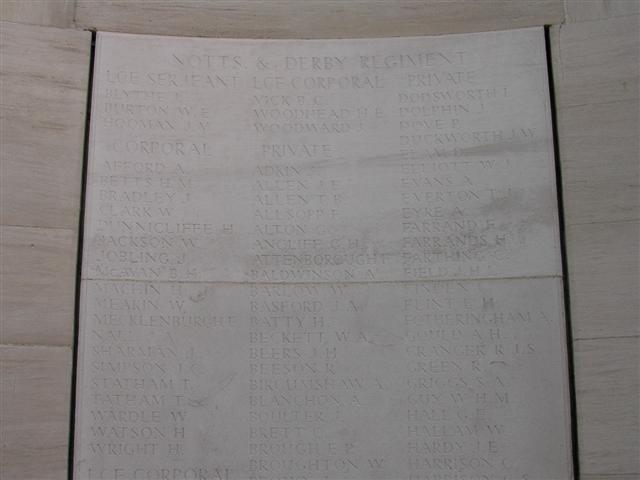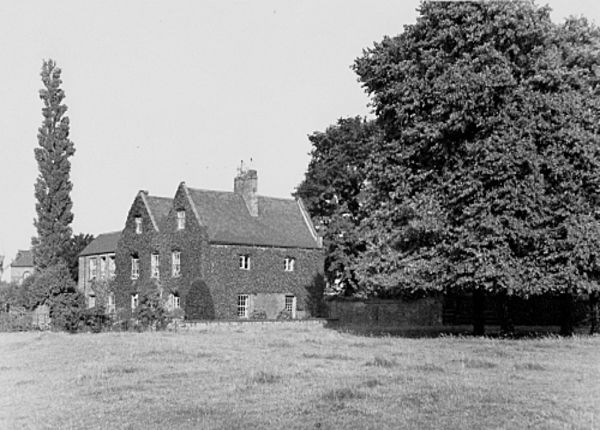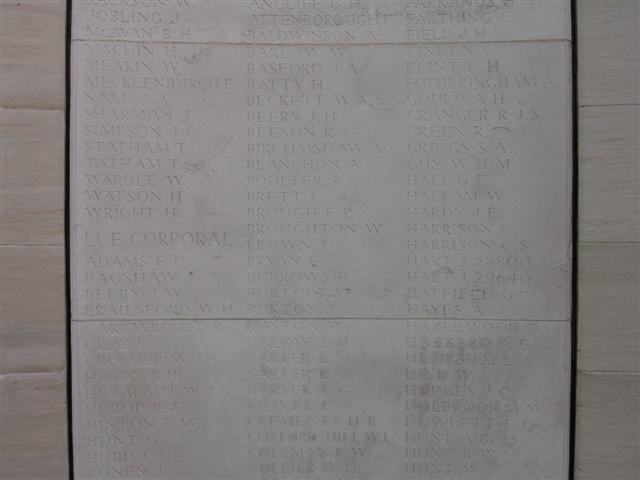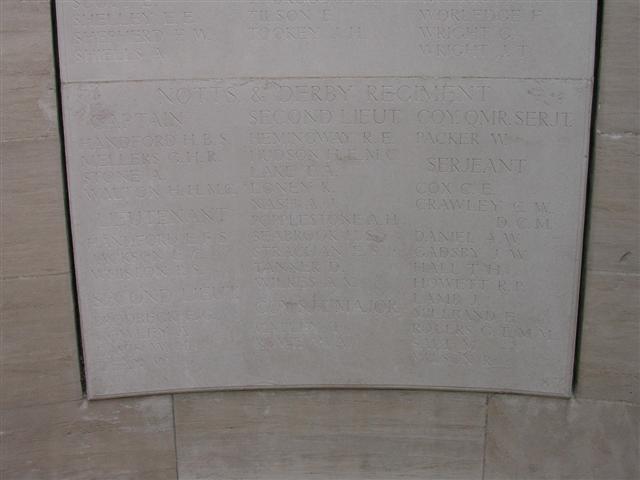Grandson of John Atkinson Walton & Jane Mary ? of Leicestershire
Harold Henry Walton was born in 1895 in Lockington, Derbyshire, the son of Edmund Walton & Harriet Ellen West. In 1901 the family were living at 6 Bridgford Road, West Bridgford, Notts. The census on this date shows his father age 36, a widower. He was an Auctioneer and Estate Agent. Harold, aged six, was the youngest of two boys, his brother Arthur was two years older and they had a sister Constance who was only three. Also living in the house were three domestic servants. Later in 1901, Edmund married a second time, to Emily Timms Bladon and the family moved to The Manor House, Chilwell.
Harold Henry Walton was educated at Oundle Public School, where he later joined the Officer Cadet Corps and developed a good shot with the rifle. He was also present at the inspection of the public schoolboys at Windsor by the King some years earlier
Upon leaving college he became articled to the firm of Walker, Walton and Hanson, of which his father was a partner and his brother was then an assistant. He joined the Robin Hoods in 1913 as a 2nd Lieutenant, obtained promotion in June 1915 and was gazetted to a temporary captaincy only a week before he was killed. He was slightly wounded twice, once in the thigh and on the second occasion in the hand, but soon rejoined his battalion after treatment.
Captain Harold Walton was killed on 13 October 1915, during the 1st/7th Sherwood Foresters "Robin Hoods" Battalion involvement in the "Battle of Loos". After many near misses, he died as the result of a German bomb in "Little Willie" trench at the Hohenzollen Redoubt. The detail dispositions for the attack by the 46th Division was as follows:
The Lincoln & Leicestershire Brigade was to attack the Hohenzollen Redoubt, having the Robin Hoods in support and the 1st/8th Sherwoods in reserve. On the right was the Staffordshire Brigade with the 6th Sherwoods in support and the 5th Sherwoods in reserve, their object being the Fosse 8.
At 12pm an intensive artillery bombardment of the redoubt and Fosse 8 commenced. The Robin Hoods from the Railway Reserve Trench watched with considerable interest this intensive fire of the artillery. The heavy guns concentrating on the village of Fosse 8, and on the bursting debris some fifty to sixty feet high. This heavy artillery bombardment cheered all ranks as they felt nothing could live under the fire. This terrific bombardment lasted an hour when an emission of gas was launched from the front line trenches followed by smoke cloud. At 2pm behind the smoke cloud, the Staffordshire men were seen to advance in regular lines, but alas this was not to last for long. They had not proceeded many yards before they were seen to be mowed down in rows. The hopes that the enemy's machine gun positions had been destroyed by the artillery before the advance was to proof false. The Germans had removed most of their machine guns into deep dugouts in the redoubt, and immediately the allied bombardment ceased they were replaced into their battle positions, and swept the whole area of the ground over which the infantry attack was made.
It was left to Captain Arthur Walton the deceased'd brother, also serving with the Robin Hoods, to telegram the sad news to his father. The next day the local paper reported the news:
Robin Hood Captain's Death - Mr Edmund Walton of the Manor House Chilwell, received information yesterday that his son, Captain Harold Henry Walton, of the Robin Hoods has been killed while on service in Flanders. It was only a fortnight ago that the young officer was included in the list of those whom the King had conferred the Military Cross in recognition of gallantry and devotion to duty.
The official description of the deeds which earned the honours for Captain Walton, then a Lieutenant, in the London Gazette, read:
London Gazette, 2nd Oct 1915 For conspicuous gallantry and energy on several occasions. On the night of 30th-31st July 1915, at Sanctuary Wood near Ypres, when ordered to re-occupy an advanced sap, he was heavily bombarded with trench mortars and rifle grenades, several of his men having been killed and buried; but by his gallant conduct he kept his men in hand and held on to his position.
Had the enemy been able to get a footing in it, the defence of the next trench would have been very difficult. On the night of 3rd-4th August he led a patrol up an evacuated trench. It was not known if it was occupied by the enemy or not, and the information he brought back was of great value. Lieutenant Walton has frequently reconnoitred close up to the enemy's trenches and obtain valuable information.
Captain Walton, who has no known grave, is remembered on the Loos Memorial and there is a memorial to him in Beeston Parish Church. Four oak trees, of Chilwell Manor, the home of the Walton family, were planted as a memorial to Harold Henry Walton, by his father in 1915 (see photos)
Arthur Atkinson Walton, Harold's older brother, rose to the rank of Captain by the end of the War. Afterwards, he took an active part in the Territorial Army (Robin Hoods), rising to the rank of Lieutenant Colonel and Commanding Officer in 1935. He was Senior Partner of Walker Walton & Hanson estate agents (now Savills) until 1958 when he retired.
The Hohenzollern Redoubt (Hohenzollernwerk) was a strongpoint of the German 6th Army on the Western Front during the First World War, at Auchy-les-Mines near Loos-en-Gohelle in the Nord-Pas-de-Calais region of France. Named after the House of Hohenzollern, the redoubt was fought for by German and British forces. Engagements took place from the Battle of Loos (25 Sep – 14 Oct 1915) to the beginning of the Battle of the Somme on 1 July 1916, including the Action of the Hohenzollern Redoubt in 1915 and the British Attack at the Hohenzollern Redoubt from 2 to 18 March 1916.
Loos Memorial - The memorial forms the side and back of Dud Corner Cemetery, and commemorates over 20,000 officers and men who have no known grave, who fell in the area from the River Lys to the old southern boundary of the First Army, east and west of Grenay. Loos-en-Gohelle is a village 5 kilometres north-west of Lens, and Dud Corner Cemetery is located about 1 kilometre west of the village, to the north-east of the N43 the main Lens to Bethune road. Dud Corner Cemetery stands almost on the site of a German strong point, the Lens Road Redoubt, captured by the 15th (Scottish) Division on the first day of the battle.The name "Dud Corner" is believed to be due to the large number of unexploded enemy shells found in the neighbourhood after the Armistice.
On either side of the cemetery is a wall 15 feet high, to which are fixed tablets on which are carved the names of those commemorated. At the back are four small circular courts, open to the sky, in which the lines of tablets are continued, and between these courts are three semicircular walls or apses, two of which carry tablets, while on the centre apse is erected the Cross of Sacrifice.
* story & pics taken from: http://www.beeston-notts.co.uk/ww1_walton.shtml
The photo of the brothers Arthur Atkinson Walton (left) & Harold Henry Walton (right), sons of Edmund & Harriet Ellen Walton, taken in 1914 when each was a Lieutenant in the Sherwood Foresters (Notts & Derby) Regiment.
.. Arthur Atkinson Walton (1892-1971) attained the rank of Captain in 1916, during his service throughout the Great War. Afterwards, he took an active part in the Territorial Army (Robin Hoods), was promoted to Major in 1929 and to Lieutenant Colonel and Commanding Officer of the Robin Hoods in 1935, continuing in the role until 1938.
.. Harold Henry Walton (1895-1915) was awarded the Military Cross for gallantry and devotion to duty in 1915, was promoted to Captain, but was killed on 13 Oct 1915 while in action in France at the Battle of Loos.
The Walton family lived at Chilwell Manor from 1904 until 1965 when the site was sold for housing development. They then moved to The Gables, Orston, near Bingham, Notts.
source: http://www.beeston-notts.co.uk/ww1_walton.shtml
Grandson of John Atkinson Walton & Jane Mary ? of Leicestershire
Harold Henry Walton was born in 1895 in Lockington, Derbyshire, the son of Edmund Walton & Harriet Ellen West. In 1901 the family were living at 6 Bridgford Road, West Bridgford, Notts. The census on this date shows his father age 36, a widower. He was an Auctioneer and Estate Agent. Harold, aged six, was the youngest of two boys, his brother Arthur was two years older and they had a sister Constance who was only three. Also living in the house were three domestic servants. Later in 1901, Edmund married a second time, to Emily Timms Bladon and the family moved to The Manor House, Chilwell.
Harold Henry Walton was educated at Oundle Public School, where he later joined the Officer Cadet Corps and developed a good shot with the rifle. He was also present at the inspection of the public schoolboys at Windsor by the King some years earlier
Upon leaving college he became articled to the firm of Walker, Walton and Hanson, of which his father was a partner and his brother was then an assistant. He joined the Robin Hoods in 1913 as a 2nd Lieutenant, obtained promotion in June 1915 and was gazetted to a temporary captaincy only a week before he was killed. He was slightly wounded twice, once in the thigh and on the second occasion in the hand, but soon rejoined his battalion after treatment.
Captain Harold Walton was killed on 13 October 1915, during the 1st/7th Sherwood Foresters "Robin Hoods" Battalion involvement in the "Battle of Loos". After many near misses, he died as the result of a German bomb in "Little Willie" trench at the Hohenzollen Redoubt. The detail dispositions for the attack by the 46th Division was as follows:
The Lincoln & Leicestershire Brigade was to attack the Hohenzollen Redoubt, having the Robin Hoods in support and the 1st/8th Sherwoods in reserve. On the right was the Staffordshire Brigade with the 6th Sherwoods in support and the 5th Sherwoods in reserve, their object being the Fosse 8.
At 12pm an intensive artillery bombardment of the redoubt and Fosse 8 commenced. The Robin Hoods from the Railway Reserve Trench watched with considerable interest this intensive fire of the artillery. The heavy guns concentrating on the village of Fosse 8, and on the bursting debris some fifty to sixty feet high. This heavy artillery bombardment cheered all ranks as they felt nothing could live under the fire. This terrific bombardment lasted an hour when an emission of gas was launched from the front line trenches followed by smoke cloud. At 2pm behind the smoke cloud, the Staffordshire men were seen to advance in regular lines, but alas this was not to last for long. They had not proceeded many yards before they were seen to be mowed down in rows. The hopes that the enemy's machine gun positions had been destroyed by the artillery before the advance was to proof false. The Germans had removed most of their machine guns into deep dugouts in the redoubt, and immediately the allied bombardment ceased they were replaced into their battle positions, and swept the whole area of the ground over which the infantry attack was made.
It was left to Captain Arthur Walton the deceased'd brother, also serving with the Robin Hoods, to telegram the sad news to his father. The next day the local paper reported the news:
Robin Hood Captain's Death - Mr Edmund Walton of the Manor House Chilwell, received information yesterday that his son, Captain Harold Henry Walton, of the Robin Hoods has been killed while on service in Flanders. It was only a fortnight ago that the young officer was included in the list of those whom the King had conferred the Military Cross in recognition of gallantry and devotion to duty.
The official description of the deeds which earned the honours for Captain Walton, then a Lieutenant, in the London Gazette, read:
London Gazette, 2nd Oct 1915 For conspicuous gallantry and energy on several occasions. On the night of 30th-31st July 1915, at Sanctuary Wood near Ypres, when ordered to re-occupy an advanced sap, he was heavily bombarded with trench mortars and rifle grenades, several of his men having been killed and buried; but by his gallant conduct he kept his men in hand and held on to his position.
Had the enemy been able to get a footing in it, the defence of the next trench would have been very difficult. On the night of 3rd-4th August he led a patrol up an evacuated trench. It was not known if it was occupied by the enemy or not, and the information he brought back was of great value. Lieutenant Walton has frequently reconnoitred close up to the enemy's trenches and obtain valuable information.
Captain Walton, who has no known grave, is remembered on the Loos Memorial and there is a memorial to him in Beeston Parish Church. Four oak trees, of Chilwell Manor, the home of the Walton family, were planted as a memorial to Harold Henry Walton, by his father in 1915 (see photos)
Arthur Atkinson Walton, Harold's older brother, rose to the rank of Captain by the end of the War. Afterwards, he took an active part in the Territorial Army (Robin Hoods), rising to the rank of Lieutenant Colonel and Commanding Officer in 1935. He was Senior Partner of Walker Walton & Hanson estate agents (now Savills) until 1958 when he retired.
The Hohenzollern Redoubt (Hohenzollernwerk) was a strongpoint of the German 6th Army on the Western Front during the First World War, at Auchy-les-Mines near Loos-en-Gohelle in the Nord-Pas-de-Calais region of France. Named after the House of Hohenzollern, the redoubt was fought for by German and British forces. Engagements took place from the Battle of Loos (25 Sep – 14 Oct 1915) to the beginning of the Battle of the Somme on 1 July 1916, including the Action of the Hohenzollern Redoubt in 1915 and the British Attack at the Hohenzollern Redoubt from 2 to 18 March 1916.
Loos Memorial - The memorial forms the side and back of Dud Corner Cemetery, and commemorates over 20,000 officers and men who have no known grave, who fell in the area from the River Lys to the old southern boundary of the First Army, east and west of Grenay. Loos-en-Gohelle is a village 5 kilometres north-west of Lens, and Dud Corner Cemetery is located about 1 kilometre west of the village, to the north-east of the N43 the main Lens to Bethune road. Dud Corner Cemetery stands almost on the site of a German strong point, the Lens Road Redoubt, captured by the 15th (Scottish) Division on the first day of the battle.The name "Dud Corner" is believed to be due to the large number of unexploded enemy shells found in the neighbourhood after the Armistice.
On either side of the cemetery is a wall 15 feet high, to which are fixed tablets on which are carved the names of those commemorated. At the back are four small circular courts, open to the sky, in which the lines of tablets are continued, and between these courts are three semicircular walls or apses, two of which carry tablets, while on the centre apse is erected the Cross of Sacrifice.
* story & pics taken from: http://www.beeston-notts.co.uk/ww1_walton.shtml
The photo of the brothers Arthur Atkinson Walton (left) & Harold Henry Walton (right), sons of Edmund & Harriet Ellen Walton, taken in 1914 when each was a Lieutenant in the Sherwood Foresters (Notts & Derby) Regiment.
.. Arthur Atkinson Walton (1892-1971) attained the rank of Captain in 1916, during his service throughout the Great War. Afterwards, he took an active part in the Territorial Army (Robin Hoods), was promoted to Major in 1929 and to Lieutenant Colonel and Commanding Officer of the Robin Hoods in 1935, continuing in the role until 1938.
.. Harold Henry Walton (1895-1915) was awarded the Military Cross for gallantry and devotion to duty in 1915, was promoted to Captain, but was killed on 13 Oct 1915 while in action in France at the Battle of Loos.
The Walton family lived at Chilwell Manor from 1904 until 1965 when the site was sold for housing development. They then moved to The Gables, Orston, near Bingham, Notts.
source: http://www.beeston-notts.co.uk/ww1_walton.shtml
Inscription
In Loving Memory Of
HAROLD HENRY WALTON, M.C.
Captain, The Robin Hoods
Of The Manor House Chilwell
KILLED IN ACTION
In The Hohenzollern Redoubt, France
Wednesday 13th October 1915
In His 21st Year
FACTA NON VERBA
Sponsored by Ancestry
Advertisement
Explore more
Sponsored by Ancestry
Advertisement









